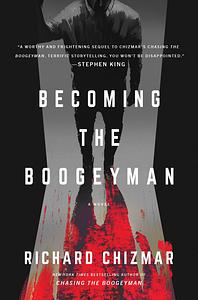Take a photo of a barcode or cover
adventurous
dark
medium-paced
“Becoming the Boogeyman” is a worthy sequel to “Chasing the Boogeyman.”
I do believe that a bit of mystery is missing having read Chasing the Boogeyman and knowing without a doubt this is metafiction. What was so brilliant about book 1 is how often you question yourself what was real and what wasn’t. Going into Becoming, I already know these answers and therefore some of that charm is gone.
However, it’s a good followup to Book 1. And dare say, that cliffy has me waiting for Book 3.
I do believe that a bit of mystery is missing having read Chasing the Boogeyman and knowing without a doubt this is metafiction. What was so brilliant about book 1 is how often you question yourself what was real and what wasn’t. Going into Becoming, I already know these answers and therefore some of that charm is gone.
However, it’s a good followup to Book 1. And dare say, that cliffy has me waiting for Book 3.
Definitely better than the chasing the boogeyman even though I’m obsessed with it as well. But becoming the boogeyman took it to another level. Richard Chizmars storytelling is very addictive and immersive. Loved it.
A devilishly good follow up to Chasing the Boogeyman, our guy Richard Chizmar is tested in every way imaginable by the sinister Joshua Gallagher. One thing is for sure, Ritchie Rich will be pushed to his limits.
loved this creepy follow-up to the original story. chizmar is such an intelligent, creative writer. i didn't feel the impacts of the metafictional storytelling quite as much in this one (because i knew what was happening) but it's still such an impressive and fun way to tell a crime story. the childhood musings in the form of memoir extracts lost me a little bit, and i found myself skimming those pages, but regardless, chizmar creates such a thorough immersive look into his neighbourhood. can't wait for the next one!
Roughly 4 stars. Better than the first book, Chizmar’s follow-up to Chasing The Boogeyman, Becoming The Boogeyman is a more intense and more traditional experience.
Chasing the Boogeyman was a “true crime” novel. It masqueraded as a nonfiction account of an uncaught serial killer. Included in it were lengthy personal memoir sections that only made sense to include because of some questionable interactions the author had with the killer. I say questionable because they don’t make a ton of sense in that book.
Becoming the Boogeyman benefits taking this relationship between the killer and the author as a given and exploring the consequences. It also is able to integrate the “true crime” elements into a more traditional thriller format by covering events surrounding the author, who is central to the copycat killer’s machinations, in what is basically real time.
The story is..mostly satisfying. There are definitely unexplained bits, and a sequel is almost assured, which I will probably read when it comes out. The revelations at the end of the story stretch the imagination a bit. It sometimes feels like Chizmar loves to include very tantalizing, mysterious elements in the story, and doesn’t really have a solid explanation when he includes them. Then, he lets it sit. If he does end up resolving it, it’s usually given a relatively straightforward and . . . surface-level . . . answer that begs for an explanation with a little bit more substance. The mysterious bite marks and the metheny connection are what I am thinking of here, for those who have read the book. Other elements, like the numerology, still go unexplained from Chasing the Boogeyman.
I enjoyed Chizmar’s personal arc in the story - his realization that he had been searching for himself through his connection with the killer, and final resolution to commit to his family. This is perfectly consistent with the last book and even sheds a bit of light on why he had been acting so suspiciously in that one. He also gets points for the dark mirror of this arc with the copycat killer, who searches for themself within the killer and go down a very different route.
Chizmar’s writing is definitely the weakest element, and admittedly I began to skim if there were any lengthy descriptive parts that didn’t advance the plot. Chizmar writes these parts with the energy and creativity of a person suffering from a migraine whose upstairs neighbor is noisily moving furniture around at 1 in the morning. There is little joy or passion when Chizmar is scene-setting, and it does make the novel suffer from a significant lack of location, aside from the frequently visited Chizmar abode.
Overall, I would recommend the book if you enjoyed the first one. It’s a solid read if you’re willing to put up with lingering story threads and some weak prose. It’s intense and mostly satisfying.
Chasing the Boogeyman was a “true crime” novel. It masqueraded as a nonfiction account of an uncaught serial killer. Included in it were lengthy personal memoir sections that only made sense to include because of some questionable interactions the author had with the killer. I say questionable because they don’t make a ton of sense in that book.
Becoming the Boogeyman benefits taking this relationship between the killer and the author as a given and exploring the consequences. It also is able to integrate the “true crime” elements into a more traditional thriller format by covering events surrounding the author, who is central to the copycat killer’s machinations, in what is basically real time.
The story is..mostly satisfying. There are definitely unexplained bits, and a sequel is almost assured, which I will probably read when it comes out. The revelations at the end of the story stretch the imagination a bit. It sometimes feels like Chizmar loves to include very tantalizing, mysterious elements in the story, and doesn’t really have a solid explanation when he includes them. Then, he lets it sit. If he does end up resolving it, it’s usually given a relatively straightforward and . . . surface-level . . . answer that begs for an explanation with a little bit more substance. The mysterious bite marks and the metheny connection are what I am thinking of here, for those who have read the book. Other elements, like the numerology, still go unexplained from Chasing the Boogeyman.
I enjoyed Chizmar’s personal arc in the story - his realization that he had been searching for himself through his connection with the killer, and final resolution to commit to his family. This is perfectly consistent with the last book and even sheds a bit of light on why he had been acting so suspiciously in that one. He also gets points for the dark mirror of this arc with the copycat killer, who searches for themself within the killer and go down a very different route.
Chizmar’s writing is definitely the weakest element, and admittedly I began to skim if there were any lengthy descriptive parts that didn’t advance the plot. Chizmar writes these parts with the energy and creativity of a person suffering from a migraine whose upstairs neighbor is noisily moving furniture around at 1 in the morning. There is little joy or passion when Chizmar is scene-setting, and it does make the novel suffer from a significant lack of location, aside from the frequently visited Chizmar abode.
Overall, I would recommend the book if you enjoyed the first one. It’s a solid read if you’re willing to put up with lingering story threads and some weak prose. It’s intense and mostly satisfying.
dark
mysterious
tense
medium-paced
Plot or Character Driven:
A mix
Flaws of characters a main focus:
Yes
dark
funny
mysterious
tense
medium-paced
challenging
dark
mysterious
medium-paced
Plot or Character Driven:
A mix
Strong character development:
Yes
Loveable characters:
Complicated
Flaws of characters a main focus:
Yes





